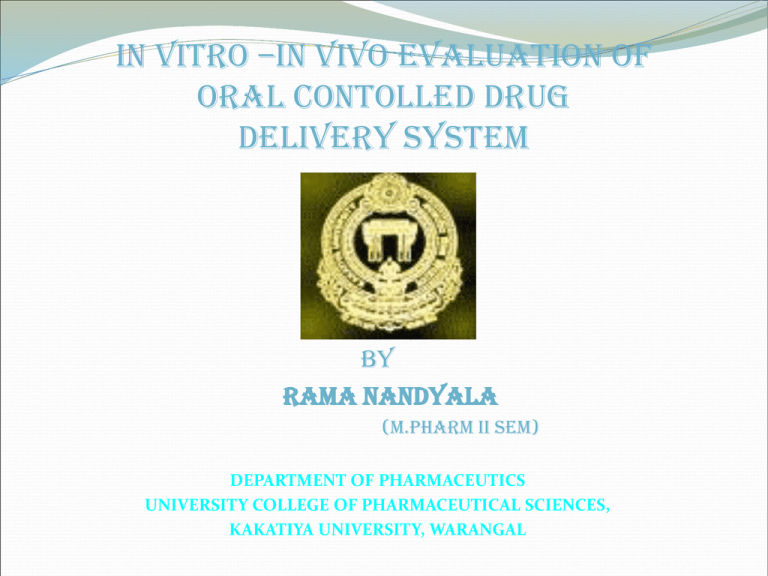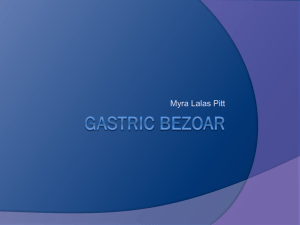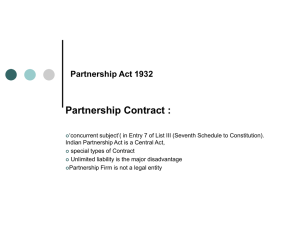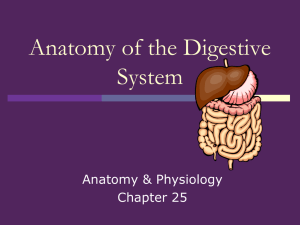
IN VITRO –IN VIVO EVALUATION OF
ORAL CONTOLLED DRUG
DELIVERY SYSTEM
By
RAMA NANDYALA
(M.Pharm II sem)
DEPARTMENT OF PHARMACEUTICS
UNIVERSITY COLLEGE OF PHARMACEUTICAL SCIENCES,
KAKATIYA UNIVERSITY, WARANGAL
CONTENTS
INTRODUCTION
ADVANTAGES AND DISADVANTAGES
ATTRIBUTES OF DRUG CANDIDATE FOR
CONTROLLED RELEASE SYSTEMS
INVITRO-INVIVO EVALUATION OF
• FLOATING DRUG DELIVERY SYSTEM
• BIOADHESIVE DRUG DELIVERY SYSTEM
• BUCCAL BIOADHESIVE DRUG DELIVERY SYSTEM
• COLON SPECIFIC DRUG DELIVERY SYSTEM
CONCLUSION
REFERENCES
INTRODUCTION
Novel oral drug delivery systems are broadly
classified into two categories as they may
controlled release dosage forms as well as targeting
dosage forms.
Generally controlled drug delivery preparations
release the drug in a contolled manner in the GIT
for systemic uptake and no particular area of GIT
specified.
Targeted preparations are releasing the drug in a
specified area or ,tissue of GIT.
Oral controlled drug deliveys system
ADVANTAGES: Increased patient compliance
Reduction in dosing frequency
Reduced fluctuations in circulatory drug levels
Employ less total drug and eliminate local side effects
Better utilization of the drugs
More uniform effect
Better control over the drug absorption.
DISADVANTAGES: High cost
Dose dumping
Unpredictable or poor invitro-invivo correlation
Reduced potential for dosage adjustment
Increased first pass clearance
poor systemic availability.
ATTRIBUTES OF DRUG CANDIDATE FOR CONTROLLED RELEASE SYSTEMS
The drug must be effective in a relatively small dose.
Drugs with biological half-life's less than one hour or greater than 12
Hrs are viewed as questionable candidate for controlled release
formulations.
Very insoluble drugs whose availability is controlled by dissolution may
not benefit from formulation in controlled release
forms.Ex:griseofulvin.
Drugs not effectively absorbed in the lower intestine as drugs with
extensive first pass clearance are also difficult to formulate in
controlled release system.
Various sites of gastrointestinal tract for oral drug delivery systems
GASTRO RETENTIVE DRUG DELIVERY SYSTEM
Orally administered controlled release dosage forms
suffer mainly from two adversities.
Short gastric retention time(GRT)
Unpredictable gastric emptying time(GET)
This can be overcome by altering the physiological
state and designing the formulations, by which gastric
emptying process can be extended from few minutes
to 12 Hrs.
Various approaches has been worked out to improve
the retention of oral dosage forms in the stomach.
Ex: Floating DDS , Bioadhesive DDS
FLOATING DRUG DELIVERY SYSTEM
Floating system have the bulk density lower than
that of gastric fluid, and therefore remain floating
in the stomach for a prolonged period.
Three major requirements for FDDS formulations are
1. It must form a cohesive gel barrier
2. It must maintain specific gravity lower than gastric
contents
3. It should release contents slowly to serve as a
reservoir.
FLOATING SYSTEMS:
Invitro-Invivo Evaluation:
Various parameters that need to be considered are,
1.Physiological Parameters: Age,sex,posture,food,
bioadhesion,health of subject and GITcondition.
2.Galenic Parameters: Diametrical size,flexibility
and density of matrices
3.Geometric Parameters: Shape
4.Control Parameters: Floating time,specific
gravity,dissolution,content uniformity,hardness
and friability
Evaluation of Floating Systems:1.Specific Gravity: Displacement method using benzene
2.Floating time: Usually performed in simulated gastric and
intestinal fluids.
900 ml of 0.1 N HCl at 37oc in USP dissolution apparatus
Marketed Preparations of Floating Drug Delivery System
S. no
Product
Active Ingredient
1.
Madopar
Levodopa and
benserzide
2.
Valrelease
Diazepam
3.
Topalkan
Aluminum
magnesium antacid
4.
Liquid gavison
Alginic acid and
sodium bicarbonate
In Vitro Floating and Dissolution Performance
Drug (Polymer Used)
Floating Media/Dissolution Medium and
Method
Pentoxyfillin
(HPMC K4 M)
500 mL of artificial gastric fluid pH 1.2 (without
pepsin) at 100 rpm using USP XXIII dissolution
apparatus. The time taken by the tablet to emerge
on the water surface (floating lag time) and time
until it floats on water surface was measured
Piroxicam (microspheres)
(Polycarbonate)
For dissolution: 900 mL dissolution medium in
USP paddle type apparatus at 37oC at 100 rpm
Furosemide
Tablet were placed in a 400-mL flask at pH 1.2 and
both the time needed to go upward and float on
surface of the fluid and floating duration were
determined.
Ampicillin
(Sodium alginate)
For dissolution: 500 mL of distilled water, JP XII
disintegration test medium No.1 (pH 1.2) and No.2
(pH 6.8) in JP XII dissolution apparatus with
paddle stirrer at 50 rpm
In Vivo Evaluation
Drug (Polymer
Method
Tranilast
(Eudragit S (BaSo4))
Two healthy male volunteers administered hard
gelatin capsules packed with microballons (1000
mg) with 100 mL water. X-ray photographs at
suitable intervals were taken.
Floating beads
Gamma scintigraphy:
In vivo behavior of coated and uncoated beads was
monitored using a single channel analyzing study in
12 healthy human volunteers of mean age 34 yrs
Pentoxyfillin
Four healthy beagle dogs (fasted for 24 hours).
Tablet was administered with 100 mL of water for
radiographic imaging. The animal was positioned in
a right lateral/ventrodorsal recumbency
Sulphiride
Three 3.5-kg white male rabbits
10 mg of the drug/kg body weight was administered
in a crossover manner with a 14-day washout period
between dosing.
Both IV and oral dosage form were given.
BIO ADHESIVE DRUG DELIVERY SYSTEM
• Bio-adhesive is the term that describes the adhesion of a
polymer to a biological substrate.
• If adhesion is restricted to the mucosal surface –
Mucoadhesion.
• Immobilization of drug at the mucosal surface would result
in;
A prolonged residence time
A localization of the drug at a target site
Increase in drug concentration gradient due to the contact
of particles with mucosal surface.
Prevents the enzymatic degradation in the GIT.
Evaluation of Bioadhesive system:
Invitro Evaluation: Dissolution apparatus either paddle or basket
Diffusion membrane method
Simple incubation of the formulation in the medium.
Evaluation of bio-adhesion properties:
1. Shear Stress Measurement of Bioadhesive Polymer:
2.Detachment force
measurement:
Used to measure mucoadhesive capacity of
different polymers.
F=0.00981 W/2
F-the force required to pull
the tablet
W-amount of water.
3.Muco-adhesion studies:
To evaluate the binding to the
mucosa as well as the
cohesiveness of the tablet.
100mM TBS pH6.8 at
37+0.5oc,cylinder rpm 250.
4.EVERTED SAC TECHNIQUE
Invivo Evaluation of Bioadhesive system :
Based on the administration of polymers to a
laboratory animal and tracking their transit through the GI
system.
Tracking followed with the help of X-ray studies,
radioopaque markers, radioactive elements and fluorescent
dyes.
X-ray studies for monitoring GI transit:
1.x-ray studies on bioadhesive Tablets:
Barium sulfate tablets of 8 mm diameter are prepared in 3
different type of polymers
Control or plain tablets of BaSO4.
BaSO4 tablets layered on one side with mucoadhesive
polymer
BaSO4 and polymer as matrix mixture in the ratio of 2:1.
2.X-ray GI Transit Monitoring of Radioopaque Microspheres:
200 mg barium sulfate loaded
microspheres are suspended in
a 1 ml 0.9%Nacl.
Male rats are anaesthetized
with methoxyflurane .
Buccal Bioadhesive Drug Delivery
Within the oral mucosal cavity, the buccal region offers an attractive
route of administration for systemic drug delivery
Because of the rich blood supply and direct access to systemic
circulation, the oral mucosal route is suitable for drugs, which are
susceptible to acid hydrolysis in the stomach or which are extensively
metabolized in the liver.
Commercially available buccal bioadhesive delivery systems:
a) Sublingual mucosal delivery of Nitroglycerin tablet:Susadrin®
b) Buccal mucosal delivery of Prochloperazine tablet:Buccastem®
c) Buccal mucosal delivery of Nicotine:nicorette®
Evaluation of Buccal Delivery System
Evaluation of buccal patches:
Patch hydration: The unprotected
patch was covered by an aqueous
medium and its weight was plotted
as function of time to evaluate the
rate of water uptake by the
patches. The swelling ratio and
rate were calculated.
The extent of hydration after
10 hr was approximately 200%
with pH 2.6 and around 1000%
with pH 7.
Evaluation of Buccal patches:
Drug release: Two methods are used to assess the
drug release from patches.
a) Dissolution using modified paddle apparatus.
b) Diffusion cell method:
Diffusion cell for determining drug release is
considered an improvement over dissolution in
that only one face of the patch is in contact with
the medium, that mimics the moist surface of
the buccal cavity.
Evaluation of drug release from chewing gums:
The cycle rate(chewing rate) is
usually set at 60/min,and 20 ml of
medium equilibrated to 37oc is
used.
COLON SPECIFIC DRUG DELIVERY SYSTEM
Colon specific drug delivery systems significantly differ from other
systems by not releasing the drug in the stomach and small intestine.
They release the drug specifically in the colon.
Colonic drug delivery has gained increased importance not just for the
delivery of the drugs for the treatment of local diseases of the colon,
but also the delivery of proteins and therapeutic peptides.
The site specific delivery of the drugs to the target receptor sites has the
potential to reduce the side effects and improve the pharmacological
response.
The colon has a longer retention time for poorly soluble drugs.
Protect peptide drugs from hydrolysis and enzymatic degradation in
the duodenum and jejunum which leads to greater systemic
bioavailability.
Evaluation of colon drug delivery system:
Various invitro -invivo evaluation techniques have been
developed and proposed to test the performance and stability of the
colon specific drug delivery system.
Invitro models:
A)
In vitro test for intactness of coatings and carriers in
simulated conditions of the stomach and intestine
Step 1
Drug release study in 0.1N HCl for 2 Hrs
(mean gastric emptying time)
Step 2
Drug release study in phosphate buffer in 3 Hrs
(mean small intestine transit time)
Invitro model:
B)
In vitro enzymatic
degradation test
Method 2
incubating carrier-drug
system in fermenter
Method 1
Drug release in buffer medium
Containingeenzymes
(e.g.pectinase,dextranase)or
or guineapig or rabbit cecal contents
Amount of drug release in
Particular time directly
Proportional to the rate of
Degradation of polymer carrier
suitable medium
containing colonic
bacteria(streptococcus
faecium or B.ovatus.
amount of drug released
at different time intervals
determined
Evaluation of colon drug delivery system:
In-vivo animal models:
A number of animals have been used to evaluate the
delivery of drugs to the large intestine of mammals.
While choosing a model for testing a colon drug delivery
system, relative model for the colonic disease should also
be considered.
For Ex. Guinea pigs are commonly used for experimental IBD
model. The eating behavior ,anatomy, and physiology of
GIT of guinea pigs are comparable to human.
The distribution of azo reductase and β-glucuronidase activity in the GIT of rat
and rabbit.
Clinical evaluation of colon specific drug
delivery system:.
Currently γ-scintigraphy and high frequency capsules are
the preferred technique are employed to evaluate colon
DDS.
γ -scintigraphy :
The transit of dosage form through the GIT can be
measured and monitored.
The γ –radiations that emerge from the subject are
collimated and detected by a crystal.The energy is
transformed to light scintillation and amplified to give
digitalized results.
Clinical evaluation of colon specific drug delivery system:
High –frequency capsule:
Smooth plastic capsules containing small latex ballon,
drug and radiotracer taken orally.
Triggering system
(High Frequency Generation)
release of drug and radio tracer
triggered by an impulse, the release
is monitored in different parts of
GIT by Radiological localization
CONCLUSION
The primary aim of oral controlled DDS is to achieve more
predictable and increased bioavailability.
Now a days most of the pharmaceutical scientists are
involved in developing the ideal oral DDS.This ideal system
have advantage of single dose for the whole duration of
treatment and it should deliver the active drug directly at
the specific site.
Invitro-invivo evaluation of a drug product is a tool to
ensure
• Performance characteristics
• Control batch to batch quality
REFERENCES
Donald.L.Wise.,Handbook of Pharmaceutical Controlled
Release Technology.,
Yie.W.Chien.,Novel Drug Delivery Systems.,
S.P. Vyas and Roop.K.Khar.,Controlled Drug Delivery.,
N.k.Jain.,Progress in Controlled and Novel Drug Delivery
Systems.,
Gangadharappa H.V.,Pramod Kumar T.M and Shiva Kumar
H.G.,Gastric Floating Drug Delivery Systems:A Review..,Ind
J.Pharm.Educ41(2007).
Alka Gupta.Sanjay Garg,R.K.Khar.,Mucoadhesives Buccal Drug
Delivery Systems:A Review Article.
M.K.Chourasia.S.K.jain.,Pharmaceutical Approches to Colon
Targeted Drug Delivery Systems.J Pharm Sci(2003).
Arora S, Ali J, Ahuja A, Khar RK, Baboota S. Floating Drug
Delivery Systems: A Review. AAPS PharmSciTech. 2005
THANK U







